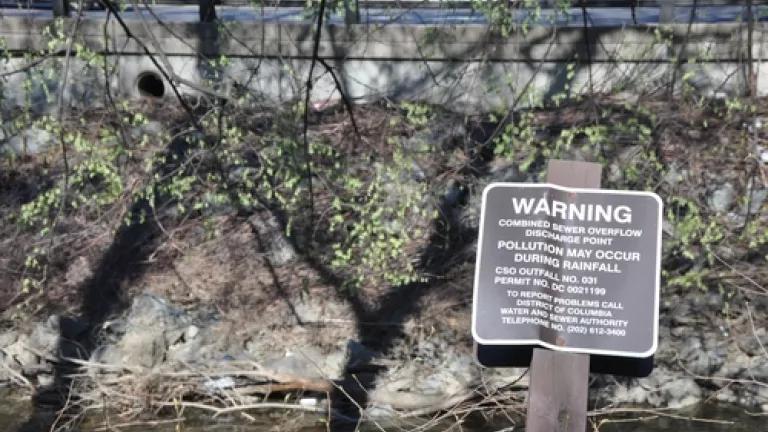
Nobody wants raw sewage in the water at our nation’s capital – but right now there are about 75 combined sewer overflows in the Anacostia and Potomac Rivers every year. Combined sewers exist in many older cities like Washington, DC. In our combined sewer system, sewage and stormwater are collected in the same pipes and transported to the wastewater treatment plant at Blue Plains in Southwest DC. To prevent Blue Plains from becoming overrun during heavy storms, the combination of stormwater and raw sewage is dumped directly into the District of Columbia’s waterways at specific combined sewer overflow outfall points along Rock Creek, the Potomac and the Anacostia.
A combined sewer overflow outfall to Rock Creek
The combined sewer system spills 1.5 billion gallons of untreated wastewater into the Anacostia, and 850 million gallons into the Potomac. In Rock Creek, there are about 30 overflows every year, spilling 52 million gallons. That is enough polluted wastewater to fill over 3,600 Olympic size swimming pools, right here in DC and flowing out to the historically troubled Chesapeake Bay.
The good news is – we know how to clean it up. Cities across the country are increasingly investing in smarter water practices called “green infrastructure” – such as green roofs, porous pavement, increased green space, roadside plantings and rain barrels – to curb the stormwater runoff that causes sewage systems to overflow when it rains. because it’s often the cheapest and most effective way to do so. You can see green infrastructure in action in the short video below (although the focus of the video is beach pollution, DC’s waterways are also threatened by stormwater pollution and can likewise benefit from green infrastructure):
If DC invests in green infrastructure improvements like this, it could reduce stormwater runoff by up to 26 percent, and could save between $1.4 million and $5.1 million annually (for every gallon that does not enter the sewer system, DC saves a penny in operational costs). If widely implemented, Rock Creek could see a 60 percent reduction and the Potomac could see a 54 percent reduction in overflows.
That’s a lot of potential savings for the city, and a lot less sewage in the waters in and around the District. And that’s why NRDC – along with the Anacostia Riverkeeper, Anacostia Watershed Society, DC Environmental Network, and Groundwork Anacostia River DC Inc. – petitioned the DC Water and Sewer Authority to update its long term plan to curb sewage overflows in nearby waterways to incorporate these smarter water practices. We also jointly urged the DC Department of the Environment and Department of Transportation to help the Water and Sewer Authority implement these practices.
The city has developed a “Long Term Control Plan” to reduce the sewage pollution that occurs as a result of overflows from its combined sewer systems. The plan includes spending $2.6 billion on three underground tunnels to store water during storms to prevent overflows. The Anacostia tunnel will be the first, and excavation is scheduled to start this spring for completion in 2018.
Our petition today does not affect the Anacostia tunnel. The sluggish Anacostia lacks the self cleaning mechanism a swift current provides, making it even more susceptible to pollution than other water bodies. The Anacostia tunnel is predicted to prevent 98% of overflows and will be a major step toward a cleaner river.
However, we believe DC Water should be more seriously examining ways to capture and infiltrate stormwater using “green infrastructure” techniques in addition to traditional storage approaches. If DC aggressively implements green infrastructure, when the time comes to build the Rock Creek and Potomac tunnels, we may find the need for them greatly reduced.
The benefits of green infrastructure don’t stop at cleaner water and financial savings for the city – studies in other cities have shown that increased green infrastructure reduces energy costs, improves air quality, and creates green jobs. It also makes the area a better place to live. It’s not hard to conceive why a neighborhood with more trees and gardens and less concrete has higher property values.

Park in Philadelphia that incorporates green infrastructure stormwater management techniques such as permeable surfaces and rain gardens
DC has already made some progress toward cleaning up its troubled waterways. It passed a 5-cent charge on plastic bags to keep them from clogging up the Anacostia (one of the river’s biggest sources of pollution) and dedicated most of the fee toward a fund to clean up the river. It also entered into an agreement with EPA a year ago, declaring they intend to prioritize “Restoring the District’s watersheds including the Anacostia, Potomac, and Rock Creek by developing an approach that considers all sources of pollution.” And it’s currently awaiting the release of a permit from EPA that will outline steps the city must take to curb stormwater runoff – we’re hopeful it will include strong green infrastructure requirements.
The city should heed our petition and further solidify its commitment to these smarter practices on land that make a real difference in the water by incorporating them into its long term plan to control combined sewer overflows.
This blog was co-written by NRDC Water Program Fellow Cori Lombard.

